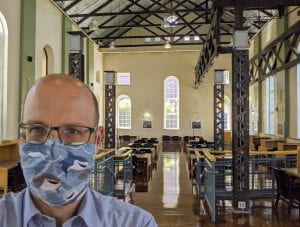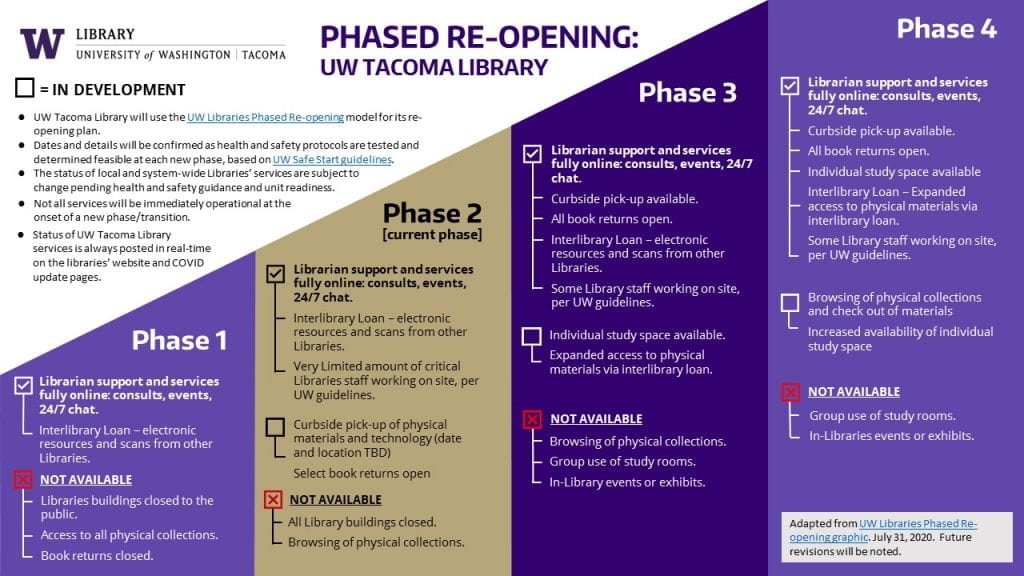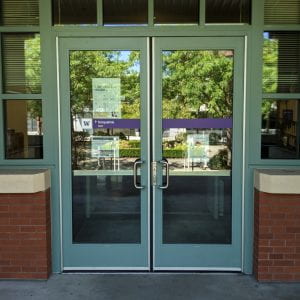Over the summer, I have participated in many Zoom discussions and training sessions about how to prevent the spread of COVID-19 as we plan for onsite work and services at the university, but a key moment in all this work came when I went to the Library a few weeks ago
On July 20th, I walked through all the spaces in the Tioga Library and Snoqualmie Buildings for the first time since our facilities closed on March 17, 2020. It was refreshing to root my perspective in actual Library spaces, and of course, I could not resist taking a selfie in the Powerhouse. Like anyone else, I long for the days when students, researchers, and visitors fill our university and Library spaces. Yet from all I have learned about how COVID-19 spreads in indoor spaces, I have become wary of any decisions based on nostalgia for the days of what I call “Before COVID-19” (or BCD-19).

Library buildings are intentionally designed to generate myriad connections between people, resources, and technology. What makes them rich, welcoming spaces to support learning, research, and communities, also makes them very risky to operate and manage during a viral pandemic that spreads quickly among people in close quarters. The question of how to bring workers first, then visitors, is something libraries across the country are grappling with, while also recognizing how desperately patrons may need our services, spaces, and resources.
The safety of Library staff and the UW Tacoma community are our primary concerns as we collaborate to plan for what will be available in Fall Quarter and the uncertain future. With this message, I would like to offer some preliminary answers to the question posed in the title.
1) We have been open virtually all along and will remain so.
With the majority of classes being delivered remotely, we will continue to provide online services and resources for students and faculty. As the university transitioned to fully online, the UW Tacoma Library also retooled and shifted its services to support remote leaning:
- Services: Librarians collaborated with faculty to deliver instruction in classes, library staff found and identified texts and resources for classes, and Research Help staff participated in UW Libraries 24/7 chat reference and have begun experimenting with virtual reference.
- Programs: The Library has transitioned many of the events and training sessions it once offered in person to an online mode. RealLit[erature] and the Staff Reads programs have brought students and staff together to discuss books have occurred fully online, and “Publish and Flourish” program has called attention to faculty faculty publications through a series of blog posts. The Digital Scholarship Summer Institute is being offered to faculty through the first weeks of August.
- Collections: The HathiTrust Emergency Temporary Access Service has opened up digital access to millions of books in the UW Libraries, and of course, we continue to offer online access to hundreds of search tools and thousands of online journals. Often, the UW Libraries Interlibrary Loan Service can also provide access to material outside of these collections, as well.
Many of these services, programs, and resources will continue to be available during Fall Quarter.
2) By Fall Quarter, we will have some limited onsite services, such as curb-side pick up.
Fluid, evolving, unprecedented — the language we use to describe the present moment barely seems able to keep up with it. This is the context in which we are developing prevention plans following UW guidelines and considering the resumption of onsite services. To navigate the many layers of uncertainty and clearly communicate with our constituents, the UW Libraries developed a graphic that maps our plans to Washington State Phased Approach, and we have adapted it to our local context in Tacoma:

Yet there are some certainties that we know. Fall Quarter will start on September 30, 2021, and given the trends of COVD-19 cases in Pierce County, we are expecting to be in Phase 2 at the start and mostly likely throughout Fall Quarter. The services students can expect to see onsite during Fall Quarter are:
- Curb-side check out of physical materials and equipment.
- Select book drops open.
3) We won’t be “opening” but phased re-opening during a pandemic.
The verb “open” is an ancient word, with over 900 years of history in the English language, and the first of its many definitions in Oxford English Dictionary applies it to physical spaces, “of a door, gate, window, etc.” When people are asking when the Library will open, they are really asking when can they pass through our front door.

In brief, we don’t know exactly when this will happen. It depends on when Pierce County and the university enter Phase 3, and it is important to remember that we aren’t opening under normal conditions but re-opening during a pandemic. Re-opening during COVID-19 means we are evaluating what specific onsite activities we can support and safely phase back into our operations while keeping workers and visitors safe and continuing to support a model of mostly remote learning.
We have heard from students that individual study space is a significant need, and we know that the Library is where they often come to find this valuable resource during normal times. As the Library considers limited re-opening during Phase 3, we are prioritizing planning for individual study space, and we will be working with campus to evaluate our spaces and develop plans that ensure safety for all those who enter our spaces. As our plans take shape, I hope to be able to share them here on blog. Meanwhile, l am participating in conversations with campus partners to coordinate our planning with other spaces that may be m on campus in the nearer term.
In tandem with this message, we have just released a message for faculty that provides guidance on how to plan for Fall Quarter, and we will be developing similar messaging for students that provides guidance on what services will be available during Fall Quarter.